Since the dawn of civilization, we have sought far and wide for a fountain of youth, whether literal or not. From the long-told fables of Cleopatra’s cow-milk healing baths to modern day dermatology, there have been an endless variety of products released and technology launched every year. As consumers, we are often told by different beauty brands that we need their products because they work wonders. The truth is, there is no magic potion, nor is there a “Benjamin button” button; however, we can definitely slow down and minimize the signs of aging, so you can look your best and feel great at any age.
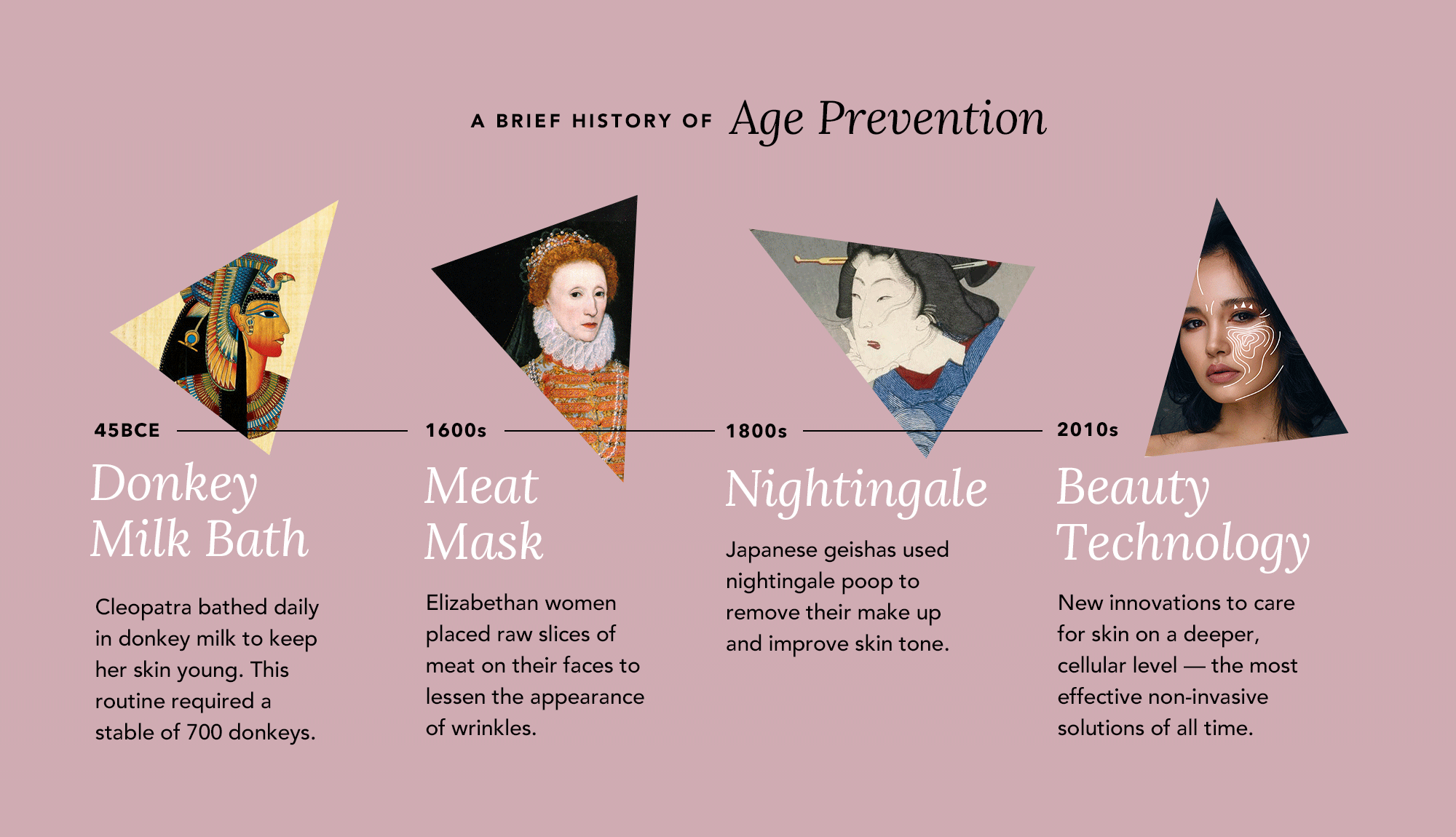
Aging is inevitable but what exactly is aging?
Before we delve deeper into the science of anti-aging, we first need to understand what aging means and what is actually happening to our face and body. While most people think of wrinkles as the primary manifestation of facial ageing, the reality is far more complex. The ageing process affects the entire facial structure, including skin, subcutaneous fat, muscles and facial bones. Ageing also affects our body. For now, we’ll keep our focus on facial aging.
Due to genetic makeup, lifestyle and many other factors, every person experiences slightly different signs, sequences and symptoms of aging. However, most people generally experience hair thinning, increased amounts of white hair, appearance of fine lines, deepened wrinkles, growing crow’s feet, a collection of extra skin and fat at the bottom of the jaw etc. Signs of ageing are cumulative effects of fat relocation, changes in bone tissue, and the breakdown of collagen and elastin fibres.
The Skin
The skin is composed of three layers: the outer layer (epidermis), the middle layer (dermis), and the deepest layer (hypodermis).
With age, our epidermis thins and starts to appear paler and more translucent. In effect, causing pigmented spots to appear in sun-exposed areas. Moreover, between our thirties and eighties, the epidermal turnover rate of our cells slows for about 30-50%. This slowdown of cell turnover accounts for the characteristic dull, rough skin surface seen in maturing skin. Such slowdown in skin regeneration, loss of collagen and muscle mass, as well as decrease in circulation consequently makes mature skin more fragile.
In the dermis layer, there lies collagen, hydroiodic acid and elastin, the crucial building blocks that support the face’s architecture; they also tend to disappear as we age, which leads to sagging and volume loss. This loss of support makes cheekbones and the nose appear more prominent. When combined with the effects of ongoing hollowing and sagging, it further enhances the visibility of fine lines and wrinkles.
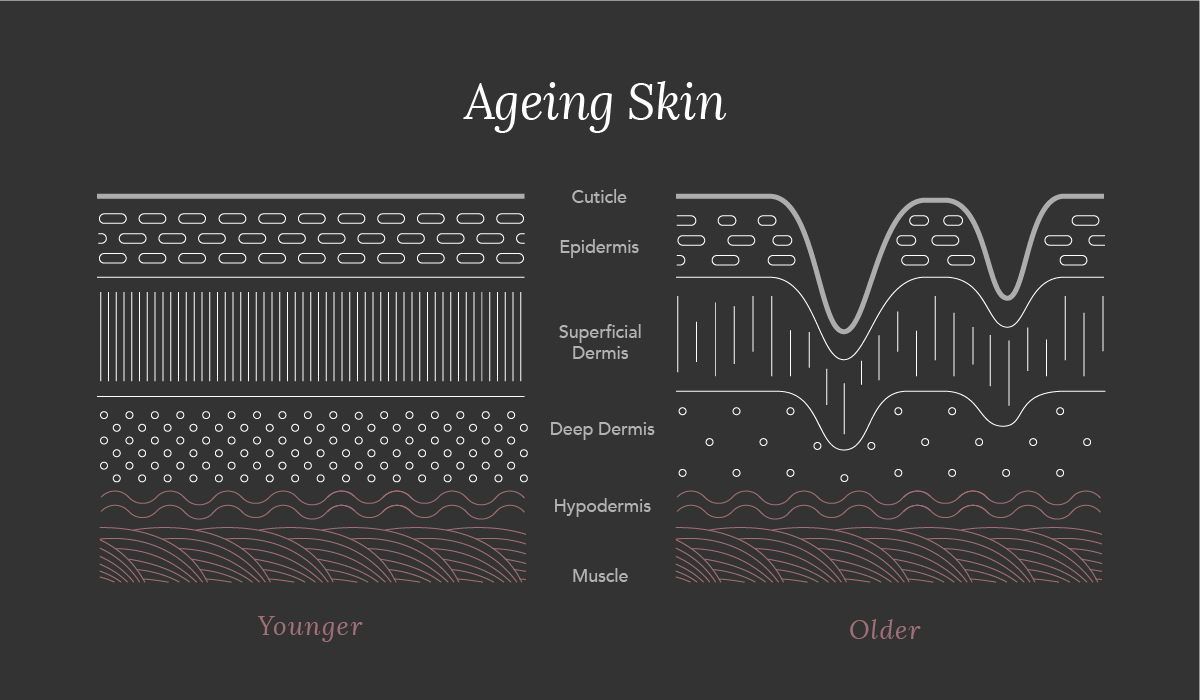
FAT LAYER
With time, fat diminishes and rearranges itself, slowly but surely moving away from those cute chubby cheeks to other new pockets which tend to be away from cheekbones, eyebrows and eyes, drifting downward to the chin, jaw and neck. This movement usually happens in our forties for women and later for men. We first lose the deep fat pads in the mid-section of the face and eventually the mouth, chin and jawline. This deflation in fat makes our skin sag and wrinkle.
MUSCLES
Facial muscles are layered between fat and bone, this system of muscles is referred to as SMAS (superficial muscular aponeurotic system). With aging, facial muscles decrease in volume and so do the fat pads, resulting in the loss of elasticity.
BONE
Our bones don’t stay the same as we age, there is an overall and gradual reduction in bone mass as we grow older. Bone also migrates with time. The eye sockets, nose and jaw are major migration points which, in time, cause the shape of the face to change. Typically bone loss can lead to narrowing of the temples, retraction of the jawline and mouth and an unstructured neck. The eye sockets widen, giving the eyes a sunken appearance resulting in a tired look. The nose also starts to descend. Skin does not shrink with age, therefore we develop a relative surplus of skin overlying the bones. This leads to overhanging seen as skin sagging.
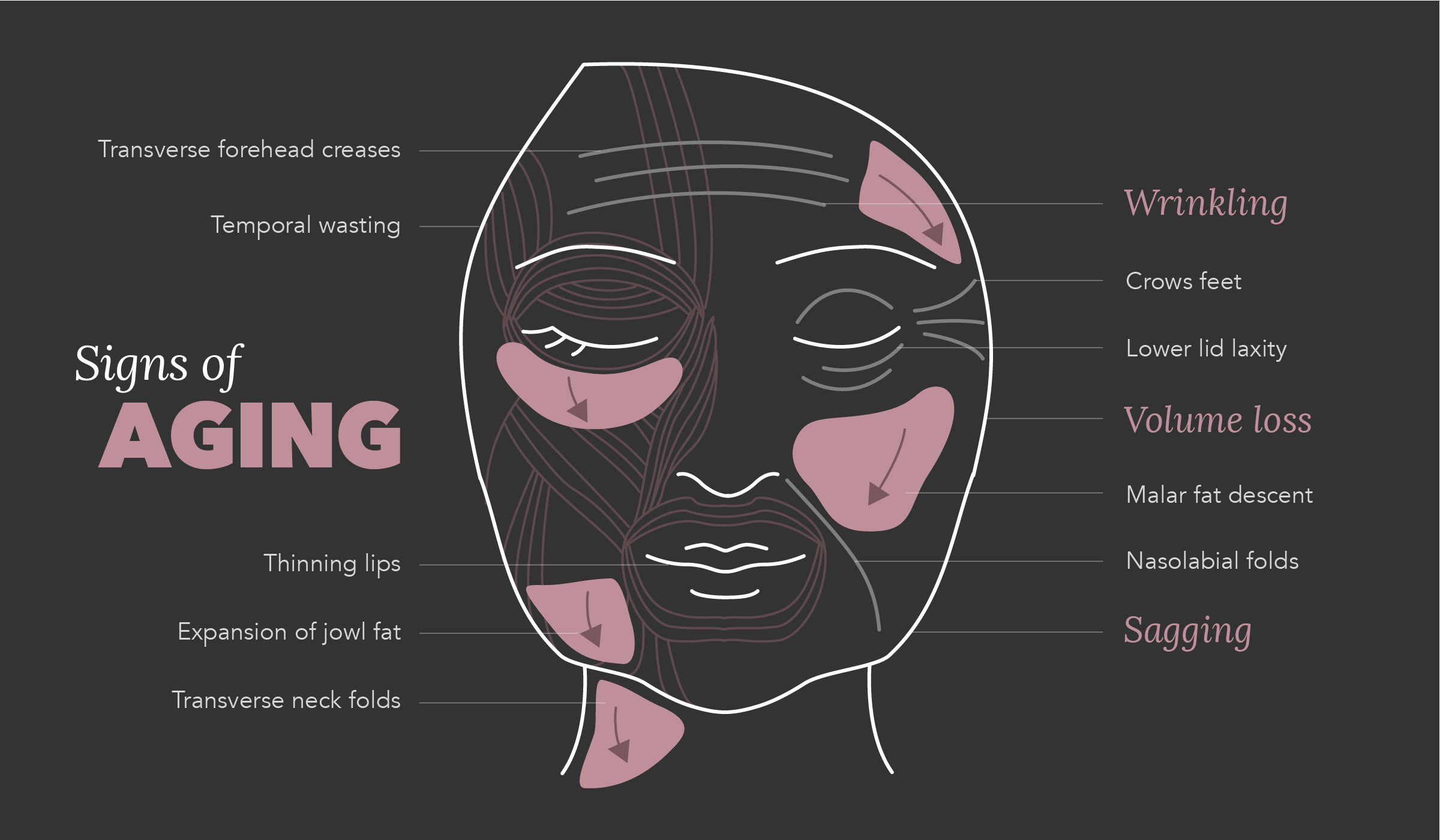
To summarize, signs of ageing is a combination of deflation, descent and degeneration.
- Deflation is the loss of the volume that occurs naturally over time, which normally results in one looking older and more haggard, - cheeks not as plumb – skin appearing loose, losing firmness.
- Descent is the collapse of facial features such as the jowls, cheeks, eyebrows, and the eyelids that often occur due to gravity and loss of volume from the erosion of bone structure and fat relocation.
- Degeneration is the change in appearance of skin, such as wrinkles, displeasing pigmentary / textural changes and redness.
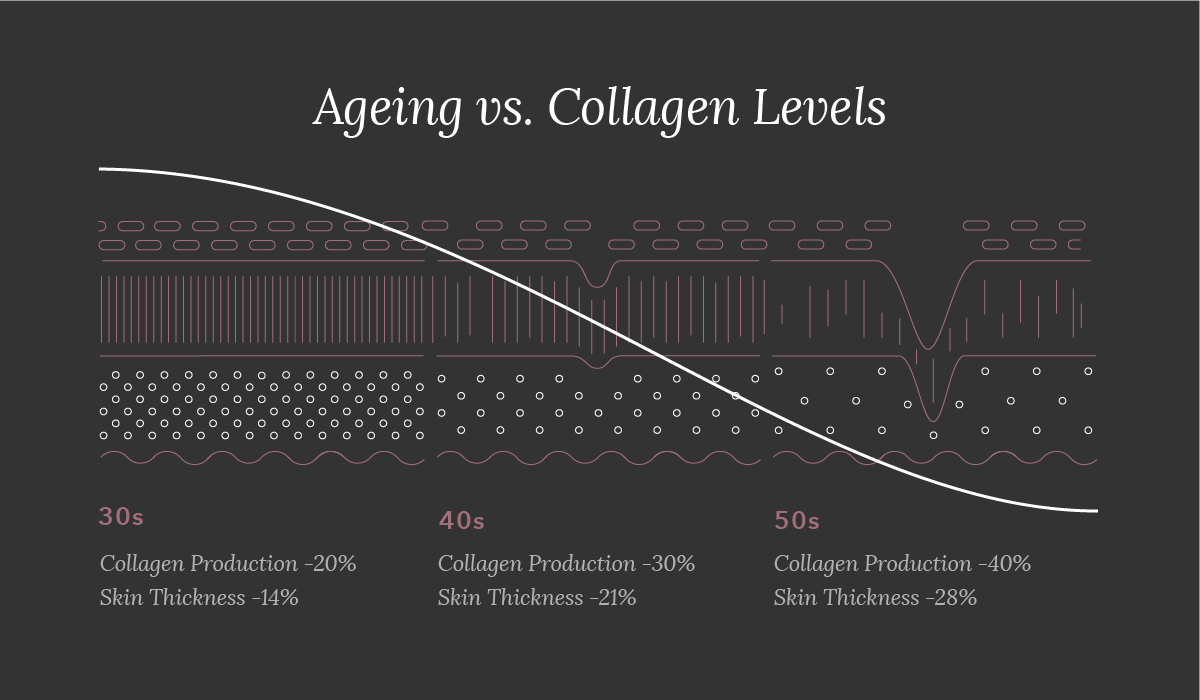
Antiaging Methodology
Afterall, aging is a natural process, and at The Artistry, anti-aging merely refers to the different methodology we can deploy to age more gracefully by minimizing and/or slowing down the occurrence of aging symptoms.
We understand that there are no skeletal approaches to anti-aging but there are treatments which target specific layers to avoid sagging, keeping skin taut, smooth and radiant. Cosmetic beauty treatments are generally categorized into 3 different types: Invasive, Semi-invasive and Non-invasive.
Invasive treatments are defined as surgical procedures where you would undergo “cut open” procedure, common examples would be silicone breast Implants, fat transfer and liposuction.
Semi-invasive treatments would refer to procedures that involve a minimal wound, like an injection such as Botulinum Toxin (aka Botox).
Non-invasive treatments are treatments that would incur no wounds and have minimal downtime, such as laser skin rejuvenations, chemical peels, Phototherapy or LED light therapy, Radio Frequency (RF) treatments and/or HIFU (High Intensity Focus Ultrasound facials. Many of these treatments can be done in beauty salons, dermatologists’ clinics or even at home.
Set out below are some common invasive procedures carried out by doctors and aesthetic professionals as well as skin treatments that can be performed by doctors, dermatologists, aestheticians. Some of which can even be done at home.
|
Face Procedures |
Skin Treatments |
|
* Eyelid Surgery – Lower * Eyelid Surgery – Upper * Facelift – Mini * Facelift – Full * Facelift – Lower * Facelift – Mid * Forehead Lift * Fat Transfer * Laser Skin Rejuvenation * Nose Reshaping * Scalp Expansion * Scalp Reduction * Facial Implants – Cheek * Facial Implants – Chin * Facial Implants – Nasal |
* Botulinum Toxin * Chemical Peel – Deep * Chemical Peel – Medium * Chemical Peel – Superficial * Dermal Fillers – Collagen * Dermal Fillers – Hyaluronic Acid * Dermal Fillers – Restylanem * Dermal Fillers – Juvederm * Dermal Fillers – Radiesse * Laser Hair Removal * Laser Skin Rejuvenation * Laser Vein Removal * Microdermabrasion * Mohs Surgery * Skin Self-Exam * Spider Vein Treatment * Sunscreen * Fat Melting – Belkyra, Kybella |
Table 1. List of procedures and Treatments by professionals
Home Use Non-Invasive Beauty Technology
Beauty technology in the home use arena has evolved drastically, we no longer need to rely entirely on beauty salons nor dermatologists to get our basic beauty treatments done. An increasing number of traditional clinic beauty devices have become increasingly compact in size, easy and safe to operate that it is possible to carry out facial treatments in the convenience of your own home. The Artistry is a strong advocate of self-care. We believe in the importance of regular maintenance, detection of early signs of aging and promoting user-friendly anti-aging devices that can be added to any beauty regime to effectively alleviate the symptoms of aging.
Home use beauty gadgets are all non-invasive treatments that have passed the standards of regulatory bodies, while also being alternative and complimentary treatments that can be easily integrated into any daily self-care regime. However, there are more than a dozen beauty technologies available in the market and over hundreds of machines from all over the world, some combining different technologies. Having a basic understanding of the common beauty technologies will be beneficial. To help you, here is a glossary and simple introduction to each of these technologies.
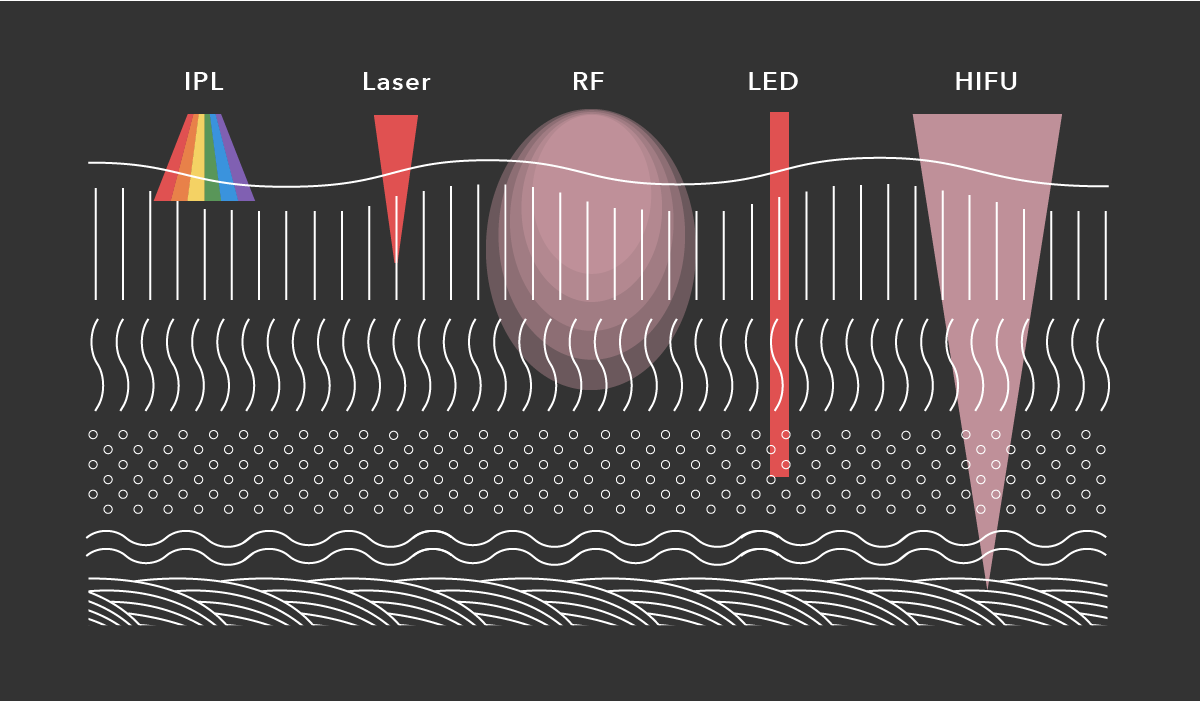
List of home use non-invasive beauty technology
- HIFU (High Intensity Focused Ultrasound) - Instant facial lifting and firming, removal of double chin
- RF (Radio Frequency) - Combat volumn loss via promoting collagen reproduction
- Laser - Focused energy for wide applications such as hair growth, hair removal, pigment removal, reduce fine lines and wrinkles
- LED Light (Light Emitting Diode Light) - Treat acne, promote skin healing, improve skin's elasticity, skin brightening
- IPL (Intense Pulsed Light) - Quick, painless, semi to permanent hair removal
- Microcurrent - More contoured appearance and aid skincare absorption
- Sonic Vibration / Ultrasound - Efficient and deep cleansing
- Microdermabrasion - Improve complexion, skin texture and smoothen skin
- EMS (Electrical Muscle Stimulation) - Exercise muscles passively for body slimming and facial firming
- Ion - Assist in skin cleansing and enhance skincare absorption
- Kneading Techniques - Massage motions improve skin health by assisting lymphatic drainage (detox) and encourage blood flow to bring nutrients to cells resulting in improved skin elasticity
- Hot & Cold Temperature - Improve blood circulation. Optimal heat temperature for collagen regeneration and cold temperature to cool down skin, tighten pores
- Derma Rolling / Microneedling - Cause systematic micro injuries to provoke natural collagen reproduction to improve skin appearance
Home Use vs Professional Use Beauty Devices
Fortunately, home use devices are far more handy than the large sized professional grade medical machines. Some may assume machines used by dermatologists are more powerful and will likely have a longer lasting effect. Sometimes that may be the case, but not always. Also, that is not to say home use devices are not effective. Many home use beauty devices are designed to be less powerful and therefore safer, thus can be used more frequently; their average treatment costs are also significantly more affordable.
|
Home Use Devices |
Professional Grade Devices |
|
|
Power |
Energy emission limited to safe operation by consumer at home. |
More complex settings, higher energy emission, needs proper training to operate. |
|
Price |
Average treatment cost more affordable |
Price can range from therapists to dermatologists. Generally, more expensive. |
|
Effectiveness |
Effective with more frequent treatment at home |
Effective |
|
Pain |
Generally painless |
Can be painful and might need to use numbing cream or anesthetics |
Considerations when deciding home use beauty devices
There are over hundreds of beauty gadgets available in the market. It might seem overwhelming to try to decide which does what and how to choose a suitable device and/or technology for you. Here are a few important things to consider:
- Your overall objectives
This will determine which technology or combination of technology would be best for your goals. Whether your goal is to remove wrinkles or to compliment your existing skincare regime, it is important to identify them first.
- Your budget ranges
The price range of different brands may vary, even if they are using very similar technology. Based on its size, power, design, material used, rechargeable batteries or its accessories, brands differentiate themselves from some of the more commoditized technologies.
- Time required for each treatment
Many beauty technologies would be able to achieve very similar goals, in this scenario, it is important to consider the time commitment for each of the treatments. At the end of the day, you need to ask yourself how you would be able to incorporate the treatments into your life.
- Treatment frequency
Some beauty technology requires more frequent treatments and some less. Similar to the point above, you need to decide whether you are able to do a treatment on a daily basis or a monthly basis. Some devices have longer lasting effects and thus require less treatment in a fixed period of time.
- Your lifestyle
Your lifestyle will dictate how successful you are with upkeeping your self-care regime. For example, if you are a frequent business traveler, having a handy home-use device that’s easy to travel with would probably be an ideal alternative to a facial appointment and a perfect companion to combat dry skin.
- Potential treatment downtime
Most of the home-use devices have zero or almost no downtime, unlike some of the semi-invasive or clinical treatments. In some cases, users may experience redness and dryness depending on which beauty technology or device you’ve opted to use. However, nothing a sheet mask and a good night’s sleep won’t fix.
- Potential side effects
Always check whether there are any potential side effects and/or any conditions that you might have that makes you an unsuitable candidate for any particular beauty technology. Generally, pregnant women are not recommended to use any of these machines. Always consult your doctor if you’re unsure.
- Machine’s usability
How user friendly is the machine. You will be operating this machine yourself at home, thus it is important to get a feel of the machine, get a demo on how to use the machine and tips on technique if possible.
.png?width=180&height=80&name=imgpsh_fullsize_anim%20(1).png)
